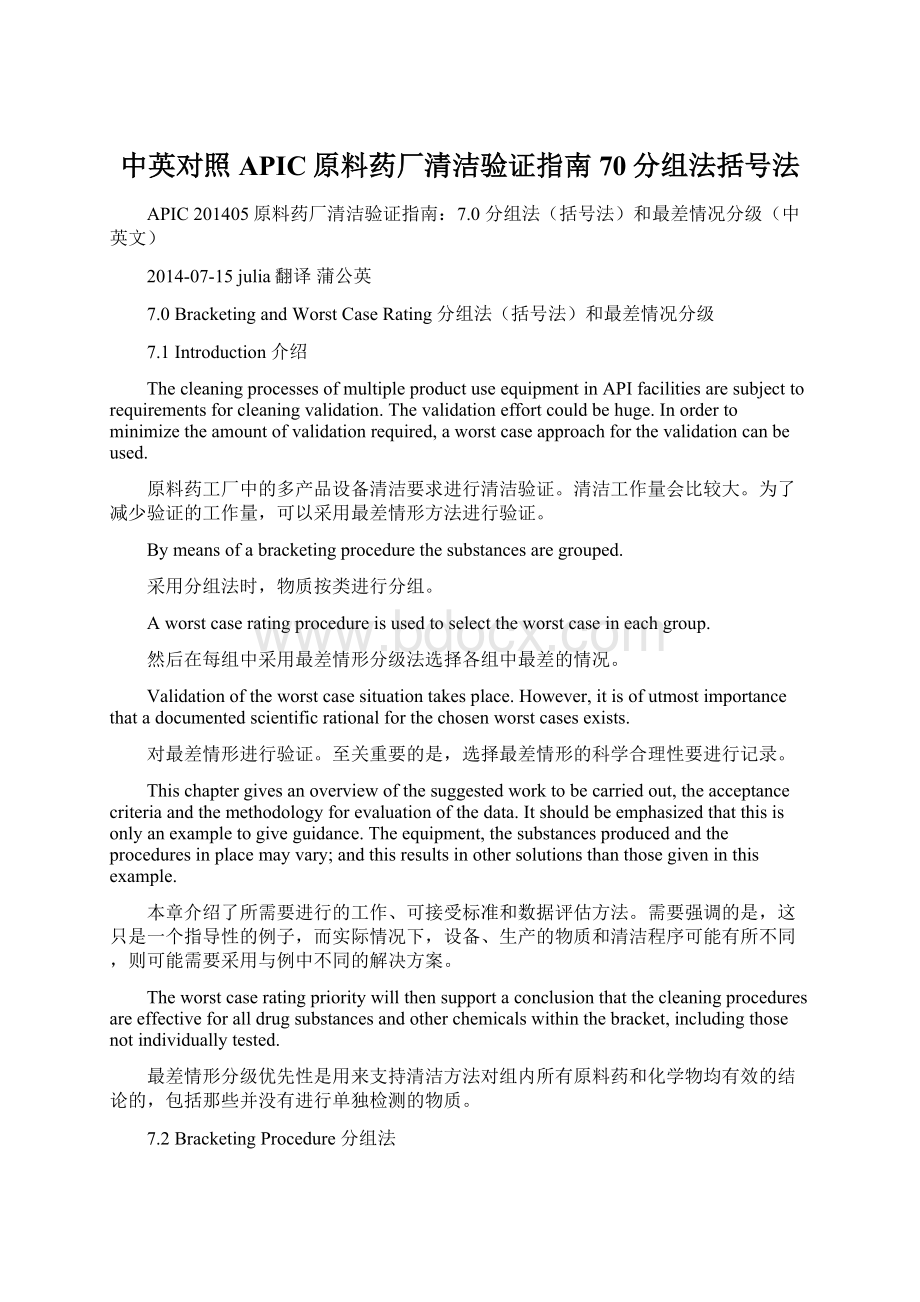中英对照APIC原料药厂清洁验证指南70分组法括号法.docx
《中英对照APIC原料药厂清洁验证指南70分组法括号法.docx》由会员分享,可在线阅读,更多相关《中英对照APIC原料药厂清洁验证指南70分组法括号法.docx(12页珍藏版)》请在冰豆网上搜索。

中英对照APIC原料药厂清洁验证指南70分组法括号法
APIC201405原料药厂清洁验证指南:
7.0分组法(括号法)和最差情况分级(中英文)
2014-07-15julia翻译蒲公英
7.0BracketingandWorstCaseRating分组法(括号法)和最差情况分级
7.1Introduction介绍
ThecleaningprocessesofmultipleproductuseequipmentinAPIfacilitiesaresubjecttorequirementsforcleaningvalidation.Thevalidationeffortcouldbehuge.Inordertominimizetheamountofvalidationrequired,aworstcaseapproachforthevalidationcanbeused.
原料药工厂中的多产品设备清洁要求进行清洁验证。
清洁工作量会比较大。
为了减少验证的工作量,可以采用最差情形方法进行验证。
Bymeansofabracketingprocedurethesubstancesaregrouped.
采用分组法时,物质按类进行分组。
Aworstcaseratingprocedureisusedtoselecttheworstcaseineachgroup.
然后在每组中采用最差情形分级法选择各组中最差的情况。
Validationoftheworstcasesituationtakesplace.However,itisofutmostimportancethatadocumentedscientificrationalforthechosenworstcasesexists.
对最差情形进行验证。
至关重要的是,选择最差情形的科学合理性要进行记录。
Thischaptergivesanoverviewofthesuggestedworktobecarriedout,theacceptancecriteriaandthemethodologyforevaluationofthedata.Itshouldbeemphasizedthatthisisonlyanexampletogiveguidance.Theequipment,thesubstancesproducedandtheproceduresinplacemayvary;andthisresultsinothersolutionsthanthosegiveninthisexample.
本章介绍了所需要进行的工作、可接受标准和数据评估方法。
需要强调的是,这只是一个指导性的例子,而实际情况下,设备、生产的物质和清洁程序可能有所不同,则可能需要采用与例中不同的解决方案。
Theworstcaseratingprioritywillthensupportaconclusionthatthecleaningproceduresareeffectiveforalldrugsubstancesandotherchemicalswithinthebracket,includingthosenotindividuallytested.
最差情形分级优先性是用来支持清洁方法对组内所有原料药和化学物均有效的结论的,包括那些并没有进行单独检测的物质。
7.2BracketingProcedure分组法
Theobjectiveofabracketingproject,isforthecompanytodemonstratethatithasascientificrationaleforitsworstcaseratingofthesubstancesinthecleaningvalidationprogram.Thefirstthingtodoistomakegroupsandsubgroups-whichwewillterm“bracketing”,fromwhichworstcaseswilllaterbeselectedbasedontheresultsfromtherating.Thebracketingprocedureshouldbeincludedinacompanypolicy,oranSOPoranequivalentdocumentoncleaningvalidation.Amultipurposefacility,CleanCompany,ispresentedasanexamplewewillfollow.
分组法的目的是让公司可以证明清洁验证方案中,对原料药进行最差情形分级具有科学合理性。
首先要做的是进行分组和分小组----我们称为“分组法(括号法)”,在一个组中,再根据分级结果选择一个最差情形。
分组流程应包括在公司方针中,或在SOP或相当清洁验证文件中。
以下的例子中我们假定有一个多功能工厂、一个清洁公司。
a)EquipmentTrainTheCleanCompanyisamultipurposesiteforsynthesisandisolationoforganicsubstances(seefigure1).Itisdividedintosixequipmenttrainsseparatedfromeachotherandintendedfordifferentuse(earlierAPIsteps,finalAPIpurification,dryingetc.).InTrainA9substancescanbeproduced,inTrainB9substancescanbeproduced,inTrainC8substancescanbeproduced,inTrainD8substancescanbeproduced,inTrainE10substancescanbeproduced,andinTrainF11substancescanbeproduced.Withnobracketingandworstcaserating,cleaningvalidationstudieswouldberequiredforeachofthe55substances.
设备链:
清洁公司是一个多功能场所,生产有机物质合成和分离步骤(参见图1)。
其设备被分为6条生产设备链,相互独立,用于不同用途(较早的原料药步骤、最终原料药精制、干燥等)。
在A链中,可以生产9种物质,在B链中,可以生产9种物质,在C链中可以生产8种物质,在D链中,可以生产8种物质,在E链中可以生产10种物质,在F链中可以生产11种物质。
如果不采用分组法和最差情形法的话,则需要对55种物质分别进行清洁验证。
Thefirstgroupingcriteriaisthatthesubstancesinagroupareproducedinidenticalequipmenttrainsandcleanedoutfollowingthesamecleaningprocedure/SOP.Theidealwithregardtocleaningvalidation(aswillbediscussedin7.3)eachtraincouldbeconsideredasagroup.Then6worstcaseswouldideallybeidentified.Inreality,thenumberofworstcasesidentifiedwilloftenbesomethingbetweenthesetwoextremes(morethan6,butlessthan55).
进行分组的第一个标准是组内的物质是在同一条设备链中生产,并采用同一个清洁程序/SOP进行清洁。
理想状态是每条链可以作为一个组来进行清洁验证(如7.3中讨论的一样)。
这样,理想状态下需要识别出6种最差情形。
现实中,最差情形的识别可能会是两个极端情况(多于6个,但少于55个)。
CleanCompany清洁公司
Figure1CleanCompany’sidealexample(1trainconsideredas1group)gives6worstcases.
InthisexamplethemainclassesinthisbracketingarebasedonthedifferentTrains.Thefollowingequipmentclassesaremaintained:
图1:
清洁公司的理想案例(设备链1被作为第一组)给出了6个最差情形。
在此例中,组内主要级别是基于不同生产链的。
以下设备分级不变:
?
TrainA
?
TrainB
?
TrainC
?
TrainD
?
TrainE
?
TrainF
b)Substances物质
Ifthecompanyhastwoormoretrainsusedforthesamepurpose(suchasearlierAPIsteps,finalAPIpurification,dryingetc.)achoiceofwhichproductstobeproducedineachofthetrainsusedforthesamepurposeisdone.Thecombinationofsubstances(startingmaterials,intermediatesorAPIs)inatraincanbechosenbasedononeormoreofthefollowingstrategies,orcombinationsofthem:
如果公司有2个或更多设备链用于同一个生产目的(例如,更早的原料药生产步骤、最终原料药精制、干燥等),已选好了在每个设备链中生产哪个产品。
在一个设备链生产哪些物质(起始物料、中间体或原料药)可以采用以下策略或联合策略来做选择:
●Produceinthesametrainsubstanceswiththesamecleaningprocedure;
●在同一设备链里生产可以采用相同的清洁程序的物质
●Produceinthesametrainsubstanceswithverylowtherapeuticdosesand/orlowbatchsizes(andtheopposite);
●在同一设备链中生产治疗剂量很低和/或批量很小(以及相反情况)的物质
●ProduceinthesametrainsubstanceswithverylowADEvalues(andtheopposite).
●在同一设备链中生产ADE值非常低(以及相反情况)的物质
Alsoachoiceofmaximumflexibilitycanbeused,butthiscouldresultinlowlimitsforresidues(forexampleifthesubstancetobecleanedouthasaverylowtherapeuticdose,andthefollowingsubstancehasasmallbatchsizeand/oraveryhighdailydose)andthuslongercleaningtimes.Advantagesanddisadvantageswithseveralcleaningprocedures,comparedtoonecleaningprocedure,willbediscussedinsection7.3.Moreexplanationsoneffectsofdifferentstrategieswillbeevidentfromsection7.4.
也可以选用具有最大灵活性的方式,但这样可能会使得残留限度非常低(),导致清洁时间会很长。
在7.3中讨论了选用几个不同的清洁程序相比于选用同一个清洁程序的优缺点。
在7.4中对不同策略的效果给出了进一步解释。
7.3CleaningProcedures清洁程序
Foronetrain,inwhichseveralsubstancesarebeingproduced,severalcleaningproceduresoftenexist.Inordertobeabletodefendthebracketingintogroups,thesecondcriterionisthatthesamecleaningprocedure(method)shallbeusedforthesubstanceswithinagroup.
对于一条设备链,如果在其中生产几种物质,通常会有几种清洁程序。
为了将所涉及的产品进行分组,第二个标准就是对同一组里的产品使用相同的清洁程序(方法)。
Cleaningprocedures(beforechangeofproducts)canforexamplebeconsideredtobethesameif:
例如在以下情况下,可以认为清洁程序是相同的:
1.Sameorequivalentissuedcleaningbatchrecords/cleaningSOPs;相同或等同签署的清洁批记录/清洁SOP
2.Samesolvent,solubilityorsimilarproperties.相同溶剂、溶解度或相似特性
Advantagesanddisadvantageswithseveralcleaningprocedures,comparedtoonecleaningprocedure,arepresentedinthefollowingtable.
下表列出了采用几个清洁程序与采用同一个清洁程序的优缺点。
Thesamecleaningprocedureforallsubstances(chosentocleanoutthemostdifficultsubstance)
所有物质(选取最难清洁的物质做验证)采用同一清洁程序
+Minimumnumberofcleaningvalidationstudies(perhapsonlyone)
-Notoptimalcleaningprocedureforeachsubstance→longercleanouttimesonaverageaswellashigherconsumptionofsolvents
-Normallyalowlimitforresiduesvalidforallsubstances
+减少清洁验证的次数(可能只需验证一次)
-对所有物质都不是最优的清洁方法→平均清洁次数会比较多,同时溶剂消耗量大
-一般对所有物质采用同一个较低的残留限度
Optimisedcleaningproceduresforeachsubstance优化每个物质的清洁程序
+Minimumcleanouttimeonaverage
-Maximumnumberofcleaningvalidationstudies(asmanyastherearecleaningprocedures)
+降低平均清洁时间
-增加清洁验证的最大次数
IntheexampletheCleanCompanyhasevaluatedthecleaningprocedures.Thecleaningprocedureshavebeenexaminedandcategorisedintodifferentclasses.Substancesinthesameclassarecleanedinthesameway,usingthesamesolventsandusuallyexhibitsomechemicalsimilaritywitheachother(e.g.salts,chemicalstructureetc.).Inthisexample,totally,fourcleaningprocedureclassesareincluded:
在案例中,清洁公司评估了清洁程序,通过检查将其分为不同类别。
同一类别中的物质采用相同方法清洁,采用相同的溶剂,通常其所含的化学物质相互类似(例如,盐、化学结构等)。
在本例中,共包括四类清洁程序:
—ClassIwatersolublesubstances.
—一类:
水溶性物质
—ClassIImethanolsolublesubstances.
—二类:
甲醇可溶性物质
—ClassIIIacetonesolublesubstances.
—三类:
丙酮可溶性物质
—ClassIVseparateclassforspecialsubstanceswithdefinedsolubility
—四类:
根据溶解度制订的特殊物质特定级别
7.4InvestigationsandWorstCaseRating(WCR)/Riskassessment调查和最差情况(WCR)风险评估
Aworstcaseratingstudy/Riskassessment,willprioritiseexistingdrugsubstances,inacleaningvalidationprogram,basedoninformationonapplicablecriteriachosenbythecompany.Cleancompanychosethefollowingcriteriawhicharerelevanttothemoleculepreparationintheirfacility(companiesshouldevaluateindividualsituations):
进行最差情形分类研究/风险评估时,根据公司选择的可采用标准,对清洁验证程序中已有原料药进行优先顺序排列。
清洁公司选择了以下标准,该标准与在该工厂中生产的产品分子相关(公司应对自己的情况进行单独评估)
a)Hardesttoclean:
experiencefromproduction;最难清洁:
生产所得的经验
b)Solubilityinusedsolvent;在所用溶剂中的溶解度
c)LowestAcceptableDailyExposure(IfADEdataarenotavailable,otherpharmacological(dose),OELortoxicitydata(LD50)maybeused(seechapter4);可接受最低日暴露量(如果不能获得ADE数据,可以使用(参见第4章)其它药学(剂量)数据、OEL或毒性数据(LD50)
d)Lowesttherapeuticdose(ortoxicitydataLD50);最低治疗剂量(或毒性数据LD50)
Inordertopresentdocumentedevidencesupportingthescientificratingforeachcriterion,investigations(aformalizedRiskassessment)shouldbecarriedoutandformalreportsshouldbewritten.Foreachcriteriongroupsofratingwithcorrespondingdescriptivetermsshouldbepresented.Whenavailable,thedescriptivetermscanbechosenfromthescientificliteratureonthesubject(i.e.forsolubilityandtoxicity).Forothercasestheratingisbasedonscientificinvestigationscarriedoutbythecompanyandcollectingexperienceregardingdetailsonthecleaningprocesses(i.e."experiencefromproduction”).
为了形成书面证据来支持各标准分级的科学性,应进行研究(正式的风险评估)并形成书面的正式报告。
每个标准中,要列出分级组所对应的描述性术语。
如果可能,应从科学文献中选取相应的术语描述(例如溶解性和毒性)。
其它情况下,分类也可以根据公司的科学研究和在清洁工艺方面积累的经验(即“生产经验”)。
CleanCompanychosetoexecutetheWCRaccordingtoaformalprotocol,inwhichtheratingsystemwasidentifiedandtheratingdocumented.InaRiskassessmentreporttheresultsincludingtheWCRweresummarised,aswellasconclusions.
清